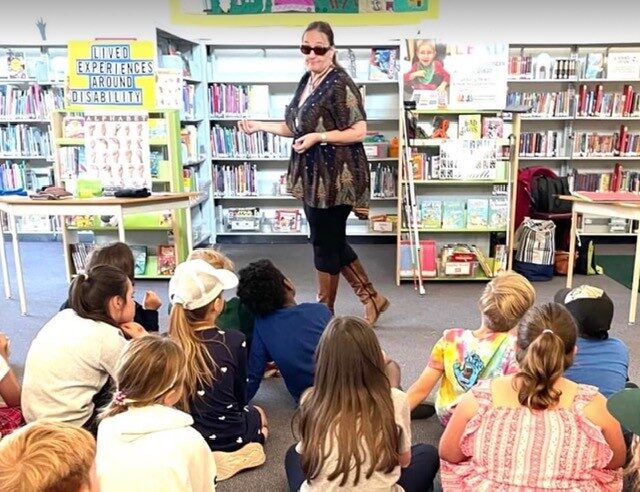
VDRC Article: Attending a LEAD presentation
Paul Frey, Writer for the Victoria Disability Resource Centre, had the pleasure of attending a Lived Experiences Around Disability (LEAD) presentation. He writes about it here.
Raising awareness among students about people living with a disability is the objective of the Lived Experiences Around Disability (LEAD) program. The program offers students the chance to think about how living with a disability is different than not living with a disability, as well as ways non-disabled students can be more helpful or empathic. The program was started by the Victoria Disability Resource Centre in December 2019.
During a session at Shoreline Middle School, facilitator Gina Martin explained to Grade 6 to 8 students that only 10 percent of disabilities are visible, whereas 90 percent are not. Gina explained to the students that because many disabilities are invisible, it’s important to remain open-minded and not make conclusions about the person with a disability.
Because every person with a disability experiences their disability slightly differently, Gina told students that accessibility is more than providing a ramp or using sign language, for example. A range of accommodations need to be available so that people with disabilities can choose what works best.
“We are all unique and all different,” Gina told the students. “It’s finding what works best.”
Gina told the students that when encountering people with disabilities, it’s important to remember that disabilities can affect either someone’s brain, or their body. She also said it’s important to ask a person with disabilities whether they need assistance before potentially providing it.
One way of building bridges between people with disabilities and able-bodied people, Gina said, is asking people with disabilities about their experience, what they find difficult and what they would prefer for assistance – if they are open to talking about their disability and how they experience it.
Students were asked by Gina to dig through a bag and identify what objects they had, simulating what it might be like for someone who is partially sighted retrieving items they might use during the course of their day. She showed them how she would place a liquid indicator on a cup, for example, that beeps when the liquid is nearing the top, so
it’s less likely to overfill. She also asked students to put on a pair of oven mitts, then pick up a pencil, write on a piece of paper, then fold it, simulating someone who has arthritis in their hands, making it difficult to write and manipulate objects with their hands.
Gina also showed students the letters of the American Sign Language (ASL) alphabet and some common signs people might use when talking about Hallowe’en. Gina talked about the importance of being mindful of one’s surroundings, so that if they encounter a person with a disability (such as someone who is blind walking on a sidewalk, or a person using a wheelchair), that the person with the disability is less inconvenienced. To demonstrate, she walked around a group of students, then had them stand aside while she passed by them a second time, indicating that it was easier for them to take one step back instead of her having to take many more steps to walk around them.
“Being mindful of what’s going on around you can really help someone else,” Gina said.
Just as actions are important to assist people with disabilities, Gina said the language we use can also have an impact. Gina talked about the use of person-first language, and the fact that a disability is only one aspect of a person’s identity.
“Anybody who has a disability, that is just a characteristic,” she said, noting it’s important to use acceptable terms when describing disability. “We can either lift people up or knock them down (with language).”
Following the presentation, a Grade 8 student at Shoreline said he enjoyed the opportunity to learn some ASL.
“I learnt that some disabilities aren’t visible and some are visible,” he said. “It was a great opportunity. I’m glad that we had this class. I think it’s important to learn about disabilities because not everybody knows or has the opportunity to learn (about disability).”
In an interview, Gina said the benefit of the program is to bring more awareness to able-bodied students of people they may encounter in the community or their peers who might have a disability and for the able-bodied students to then be able to support people with disabilities if they request it.
“(The program is designed) to let students know that we are all individuals; no two people are the same and no two people do things exactly the same way,” she said. Gina noted that not everyone with a disability has the same support system, nor do people have the same access to resources or aids.
“Not everybody has the opportunity for training, rehabilitation or supports. Not everybody (with a disability) is at the same acceptance in their journey and not everybody knows that they have a disability, so just being able to communicate our needs specifically, takes the guesswork out (of communicating),” she said.
Since the spring of 2022, the LEAD program has visited 12 schools encompassing 42 classes. Among more than 700 students that have participated in the program, 136 identified as having a disability. A further 313 students said they knew of someone with a disability and 314 students knew more than one person with a disability. The program began in December 2019, then took a bit of a break due to Covid-19, before resuming again last spring.
“Disabilities are really common and well-known in schools to people, either affecting them or someone they know. We need to have more conversations around disability because anybody can develop a disability at any time,” Gina said.

Comments
There are currently no blog comments.